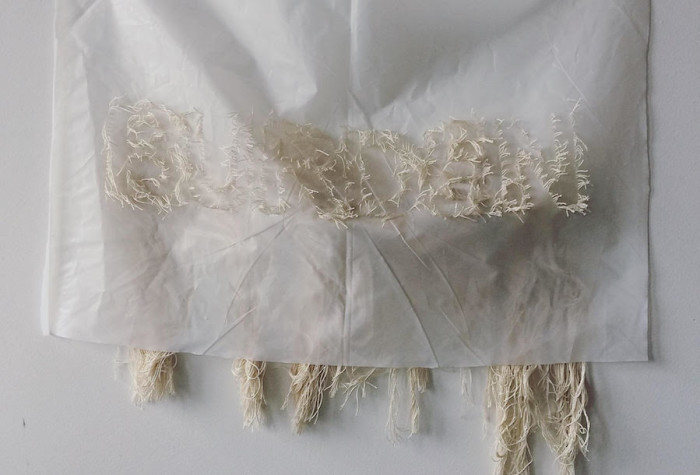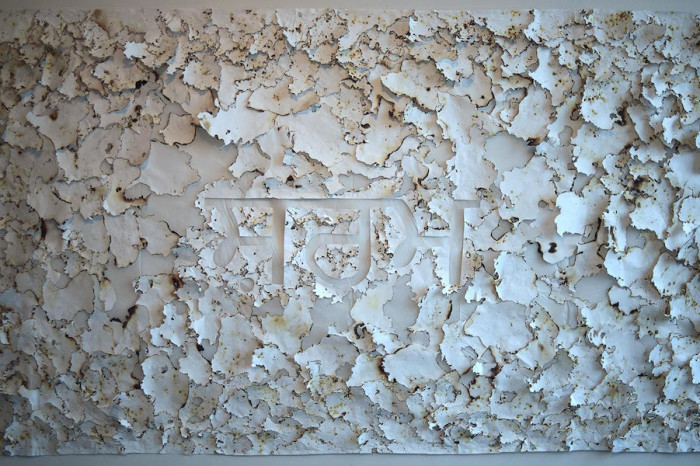At a time when women’s bodies and reproductive rights are being threatened on the national stage, Seattle artist Satpreet Kahlon takes a breathtakingly human and intimate approach to discussing gender violence in her new exhibit, “What’s Left Behind,” now showing at the Ethnic Heritage Arts Gallery in the Seattle Municipal Tower.
Her work does not approach the subject matter as propaganda but rather undresses the daily struggles of survivors. She explores the aftermath of sexual violence with visual art that is all at once ethereal, gorgeous and haunting.

As a writer and performance artist who has been active in the movement to end domestic and sexual violence, I am moved by Kahlon’s ability to evoke the seemingly invisible legacies of gender violence in an emotional and visceral way.
For example, “Believe Me, 1 & 2” (fiber and plastic) consists of two separate pieces of opaque plastic that have been carefully threaded with long pieces of white string to spell the word “burden.” Behind one sheet of plastic lies a knotted mass of fiber similar to hair hidden under a cloth. The twin piece brings the the tangled mess to the surface.
“[For] anyone who has survived a serious trauma, that is how you live your life. You are always living with it just beneath the surface,” Kahlon says. “So what happens when it’s exposed?”
The viewer is forced to ask this question of themselves as they view the exhibit. Though we are not treated to statistics about a person’s likelihood of experiencing sexual violence, one cannot help but wonder how many survivors are drawn to view the work.
If one is a survivor, how many others with similar experiences are standing next to her? “What’s Left Behind” creates space in which a conversation about these shared experiences can take place.
Kahlon was born in India, grew up in Chicago and is a recent transplant to Seattle. She addresses her experiences as an immigrant — not only in the content of the work — but also in her choice of materials and methods.
“I use a lot of traditional materials from Punjabi craft, like fibers and silk chiffon,” Kahlon explains. “But I use it in conjunction with more industrial and American materials, and and I manipulate it in a way that is not traditional. The mix of the materials and the processes is my way of consolidating my identity.“

Another way that Kahlon straddles the duality of identity is with the white monochromatic color palette present in several of the pieces. While the color white evokes purity in a Western context, in South Asia, white is emblematic of grief and mourning. The show takes on different meanings for an audience, depending on their cultural heritage.
All of the pieces demonstrate the marks of violence. “Believe Me, 1 & 2” contains strings that have been cut and the plastic sheeting bears multiple puncture marks.
Another piece shows a carefully constructed braid that has been cut at the top. In South Asian cultures, a woman’s long hair can represent her honor. Sexual violence can disturb this sense of wholeness as if one’s braid was raggedly shorn from the head. The centerpiece of the show, “Sharam,” has the word shame, or sharam, in Punjabi, cut out of the center and surrounded by overlapping sheets of burnt paper.
And yet, despite the jarring nature of some of Kahlon’s methods, the impression left by the exhibit as a whole is one of vulnerability and openness. She describes this meeting of hard and soft as “acts of tenderness and care, but also violence, that are strangely beautiful.”
In her artist’s statement, Kahlon asks the viewer to consider the experiences of women of color who live with the trauma of gender violence and their attempts to heal, while advocating for racial justice for their communities.
By embracing traditional materials and Punjabi language, the exhibit demonstrates an embrace of culture and race with a courageous willingness to speak out against injustice within one’s own community.
Kahlon’s exhibit is a testament to the resilience of the human spirit.
“What’s Left Behind” will be on display at the Ethnic Heritage Art Gallery in the Seattle Municipal Tower through April 15. The gallery is dedicated to supporting work by artists of color and bringing art to public spaces to spark conversations around social justice. More about Kahlon at www.satpreetkahlon.com.


Afrose, great to see that you are writing on this important topic. Just read a powerful article ( “Reclaiming my voice”) by UC Berkeley student, Gautami Sharma on “Sex without consent” and gender violence disq.us/97ps4e